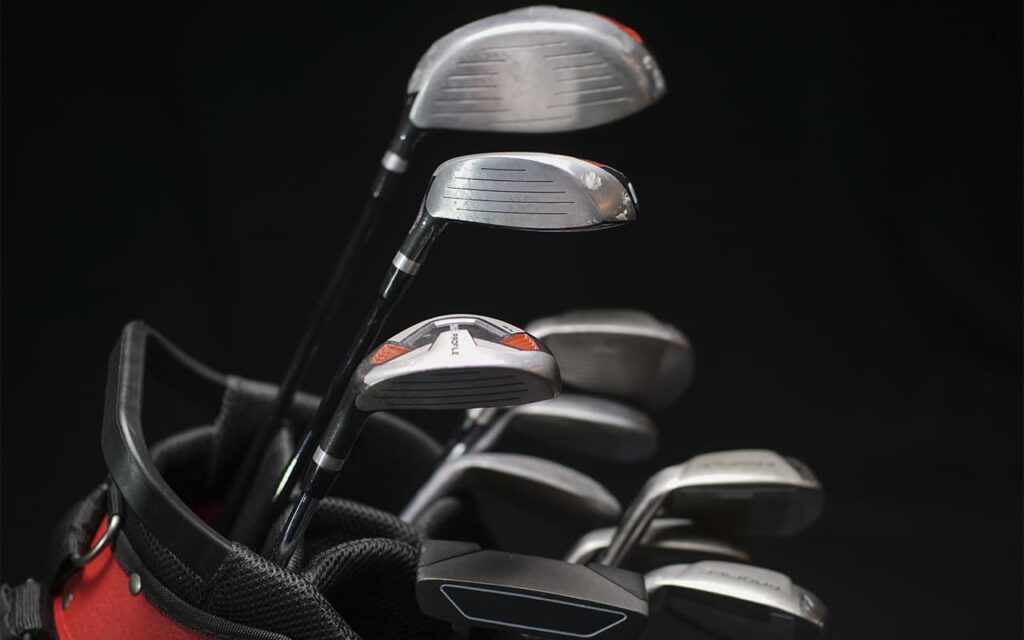In the 1930s, players used so many clubs that caddies suffered under the weight of 25 clubs that had to be carried in huge bags. That’s when Royal and Ancient as well as the United States Golf Association came to an agreement on a maximum of 14 clubs.
Early in their careers, beginners are advised to buy half a set. This might be a No. 3 wood plus a No. 5 or No. 7 wood, supplemented by even or odd irons. If you want to follow this advice, look for a putter that is sold as independent equipment – this will allow you to add additional putters to your half of the set as your skill grows.
It is not necessary to have the same model of woods as the irons. However, it is advisable to purchase a set of matched irons that are similar in weight and balance.
Drivers are made with a club head angle of 7′ to 12′. While professionals taking part in tournaments can be satisfied with an angle of 7′.
Knowing the construction of golf clubs will help you choose the ones that work best for you. Choose a club with a comfortable shaft. In the case of choosing an iron, this is less important than when choosing a wood. When you purchase a driver, you need to pick the right rod. If you use a rod that is too stiff, it will result in low pitch and deflected strokes to the right. If the rod is too soft and flexible, it is difficult to control the flight direction of the ball.
Rods are usually categorized as follows: E – hard, I – regular men’s, A or senior golfer’s rod (suitable for older men and women with a high game class or high height), and I – women’s. Some rod types are listed in numbers, but your coach can tell you how these numbers relate to regular men’s and women’s rods. Do not use a stiff rod if you are not sure you can handle it.
Regular men’s rods are suitable for almost all club players who are men. Women’s club rods are suitable for most women.
Taller women who prefer longer rods are advised to use a senior rod.
Take care of your clubs. Whether your clubs are made of metal or wood, you need to protect them with head covers. If they get wet, remove the covers after the game is over and wipe them dry.
Keep the woods in good condition by wiping with polyethylene varnish where the coating has been damaged. If the face markings are bad, apply a small amount of linseed oil and let it dry before applying varnish.
Choosing golf clubs is extremely important. This does not mean buying very expensive equipment, but you should select clubs according to your height, strength, and overall playing style.
Most players can use standard length clubs. However, people vary greatly in height, and their hands are usually about the same distance from the ground. Men between 160 cm and 180 cm can use standard length clubs, the same goes for women between 155 cm and 168 cm.
It should be remembered that if you increase the length of the club, the rod rises, the head seems heavier. If you shorten the club, it becomes less flexible and your hands feel worse. Tall players in particular often have difficulty with clubs that are too short, especially short irons.
It is often very important to have a proper club line, in other words, the angle at which the club is positioned relative to the ground when the player takes the baseline stance. If the player is tall, or if he holds his hands high, the heel of the club may go up, and the toe will tend to hit the ground, resulting in a slice. That’s why a tall player should carefully check the stick’s position.
Buy clubs with the right thickness, gri-fingers of the left hand should touch the thumb pad only slightly. Keep the grips in good condition, wash them regularly with warm water.
If you bought a new set of clubs with ill-fitting grips, ask your clubmaker to adjust them to your needs. The grips should be egg-shaped, not round. Therefore, if the grips are not fitted correctly, you will have difficulty keeping the club face straight and bringing it to the ball evenly.
An experienced golfer should be able to select a club with their eyes closed by turning it around and placing their hands on it – feeling the gripe.
The thickness of the gripe is very important for good hitting. Some adjustment can be made by wrapping tape around the stick. Almost all professionals use a patter with a flat front gripe. This ensures proper grip – thumbs in front and hands at the sides. Always check the striking surface of the patter. This is the hitting area of the front part of the putter that gives the correct stroke.
Patters usually come in four types – putter shaped putter, putter with a hammerhead, putter with a rod at the middle of the putter head, with mass distributed to the heel, toe and sole of the putter head.
The latter two types have the greatest likelihood of the greatest impact surface. Compared to these, the old-fashioned putter is very hard to use.
Patters vary in length from 80 to 90 cm. The angle of the face of the putter can range from 3° to 7°. Patters with a small angle are ideal for competitive greens. Large angle putters can be used on poor greens or by players who put their hands in front of them at the baseline. A lightweight putter can be very difficult to control, while a heavy putter encourages even swing.
Choose the patter with a flat grip – it is more comfortable to hold correctly. And remember: the shaft should be at least 10″ out of the vertical.
